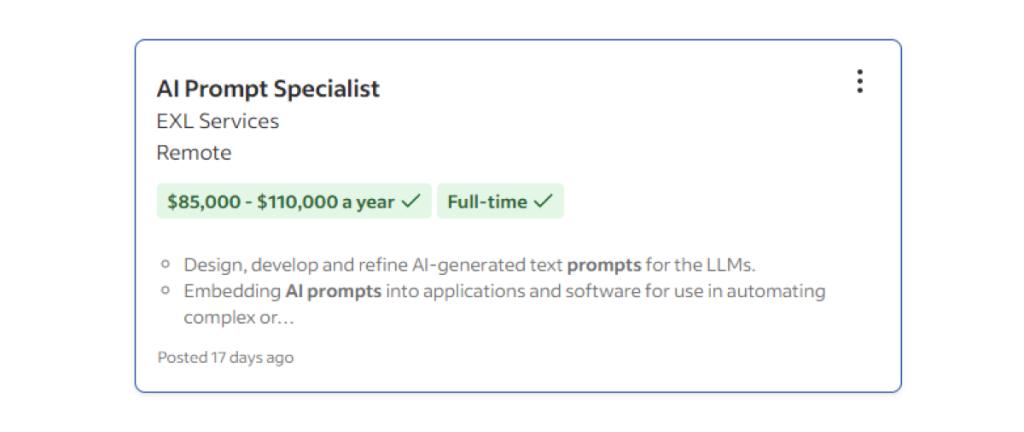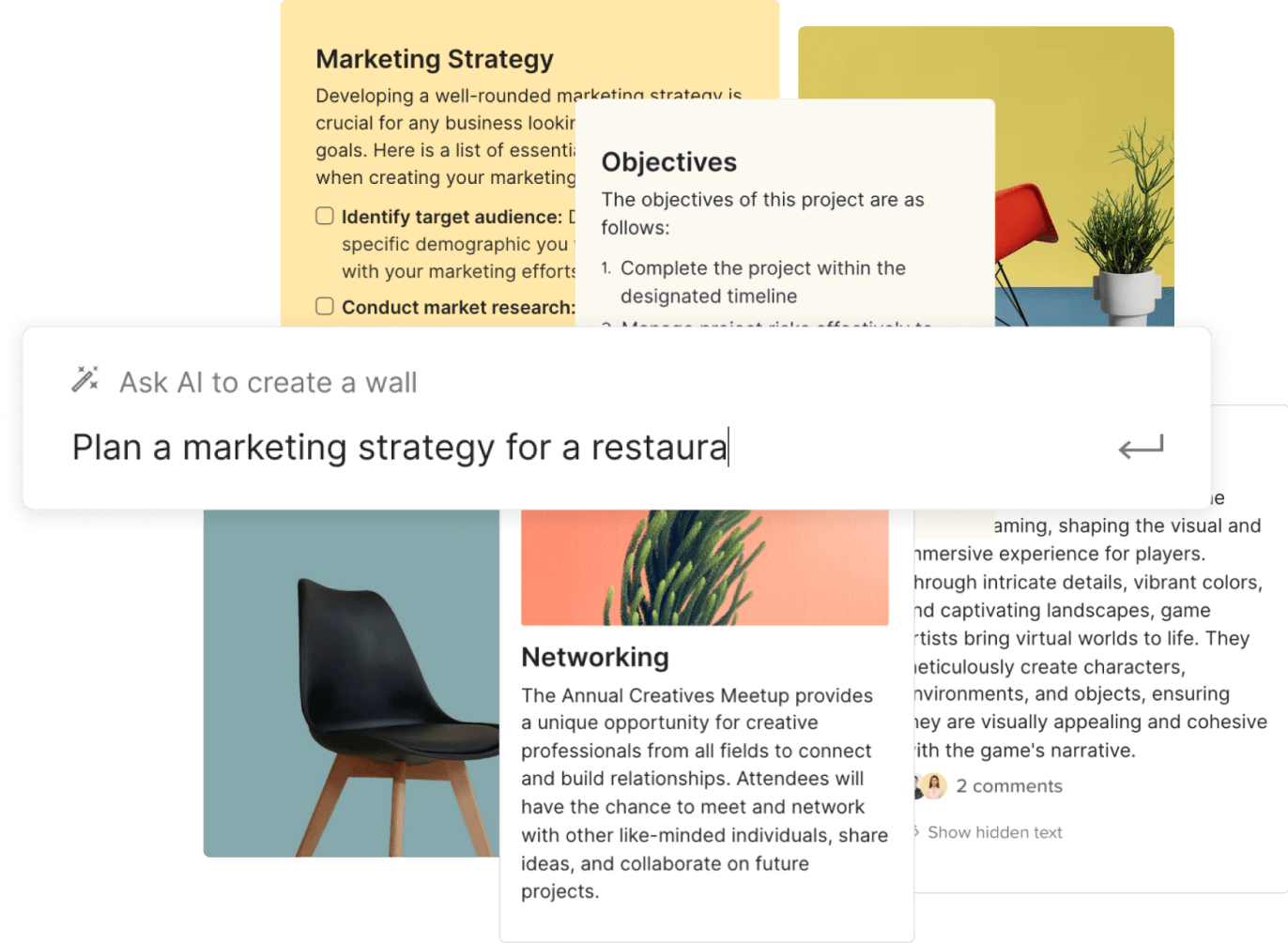Writing an effective AI prompt isn’t exactly simple. I mean, heck, it’s a full-blown profession now. *Briefly searches indeed for prompt engineer positions, mouth agape at the salaries.*

So if these companies are willing to pay entire salaries towards someone who can create great… prompts, then there must be more to it than simply asking a question. Now, before we quit our day jobs, let’s chat about how to write an effective AI prompt.
1. Explain it like I’m 5 – Sincerely, the AI
Now you may be completely fresh to AI prompting, or you might have dabbled in it a bit so far. Either way, I think it’s good to review some of the general rules of thumb regardless.
One of the main things to focus on when prompting an AI is just making sure that you are being as clear and specific as possible. I think one of the hesitations we often have in prompting the AI with something very complex is we might feel like it’s too much, or our question is not phrased properly. That might be the case, but realistically, that is one of the biggest strengths of AI; it can parse large, natural language queries. Sometimes, we really can treat it as if it was an expert that we’re just chatting with.
2. De-Google-ify your noggin
I think a lot of us are used to asking our questions to Google. The way that we have gotten used to phrasing those questions to Google can sometimes not be super effective for talking to an AI. We’ve been conditioned to think that the more nuanced our question gets with Google, the less likely it is to give us the answer that we need. Whereas the opposite is more often true with ChatGPT and other large language models.
An example of a simple query might be:
Help me create an email campaign.
A relatively simple query you might ask Google about. How does one create an email campaign? You’d likely get a slew of generic rules of thumb, articles that’ll help you figure out how to get started and the right tools to get you there. That’s all great and can still be extremely useful, especially if you’re just starting.
But if you are looking for more nuanced assistance with the actual task of completing that, something more specific might be:
I’m creating an email campaign to educate our customers about the custom-tailored website services we offer. What content should the campaign focus on?
In this example, we’re addressing the intent of the email campaign, we’re addressing what the email campaign is going to be about, and then asking specifically what would the AI suggest the content be focused on. Whereas, if you tried literally googling that, you’d be immediately directed to top-ranking links that have matching keywords. But not necessarily in the right contextual order and therefore not quite as useful.
Update, I just tried googling it. No dice. The top 10 links had nothing to do with website design and only focused on email marketing.
3. 🎵 Tell me more, tell me more 🎶
The more information that you can give the AI, the better the results will be. Context can look like a lot of different things. It can be:
- Background on yourself
- What you’d think would be important for the AI to know to try to develop a solution for you.
- For example, with our email campaign, if we then told the AI:
- We are a super young company that’s only been around for about a year.
- We have a small email list.
- List a few of the services that we currently offer that are doing well for us.
All that context will give the AI a better idea of how to shape the content of the email campaign to deliver better results.
That’s another great part about AI and ChatGPT. Through the process of prompting with it, you can put one prompt in and then add on to it with your next prompting. The AI will then use everything you’ve told it before and add that and aggregate all the information you’re telling it into one cohesive experience that it is then deriving its answers off of essentially.
It’s wild. I mean, if all you’ve grown up around is Google searching, then it’s a very different experience. I think once you get your hands on it and you tinker around with it, you really start to understand what that feels like and what you can actually do with it.
4. Get down in the dirt
Probably the most crucial piece of advice is just trying things out in many different ways and seeing what works for you. Get messy with it!
You can read endless articles, such as this one, about how to make a good AI prompt and how to “hack the system” so-to-speak. Don’t get me wrong, there are some tried-and-true things that you can learn from others who have already put in the time. But also, I think everyone has a somewhat different use case for AI. Everyone’s needs and desire to integrate with AI is different. It’s all about really just getting your hands dirty and trying different things.
For example, you could assess your prompt for any metaphoric sentences or phrases. Things that might be common knowledge to you and I, but it might not be so clear to an AI who isn’t able to understand metaphors quite the same way. What can you do to provide clear instructions to the AI? Analyze your prompts from that perspective. Try to be as literal as possible. It’s a great way to try to further improve your prompting. Granted, that only comes from experimentation and iteration.
5. Take notes! No, seriously
One of the best things you can do to help shift your mind towards effective prompting is taking good notes on your prompts. The methods in which you do so are entirely up to you, but usually I’ll just have a notepad document open to have as a scratch pad. Then, my process looks like this:
- I don’t think about the first few iterations of my prompt too hard. I just go with my gut.
- I copy them from my prompt interface and paste them into my notepad document as I go.
- I’ll usually use the scratch pad to cut words and move them around more easily before pasting them back into the prompt interface.
- If I start going down a multi-prompt path, I’ll use some kind of visual indication in the notepad document, like an indent, to show what prompt is the parent and which are the subsequent children.
- As I go, I’m adding notes to the prompts about the results I saw, what was missing from them or what I thought was the right kind of response.
- I then try to start isolating the pieces of the prompt that are giving me the right responses versus the wrong responses so I can make new combinations.
- Then I just repeat this process as much as I see fit, telling the AI to forget all previous inputs as needed.
It’s partially just about training your own brain, but it’s also about comprehending what these large language models look like and how they interact with the words you give them. Not to mention, all the AIs that are currently out on the market are a little bit different. You have to take one’s responses as a grain of salt. If you go from Google Bard to ChatGPT, they’re going to give you two different answers because, for example, Google Bard has access to the Internet, whereas ChatGPT does not. That, and they’re also trained on different data sets entirely so… yeah. Their theoretical “genetic makeup” is not the same. These are all things to just keep in mind when it comes to becoming good at prompting in the massively expanding world of AI.
It’s not about being perfect from the start. It’s about us learning how to interact with them in a way that is new to us while still being effective for what we’re trying to do. It’s about understanding that these large language models are still very young and will change over time. Spending time in prompting now will only become more useful as these AIs inherently evolve.
6. Double-check it, then check it again
Ultimately, the AI output is a great starting point. Yet, the best results come from a mixture of AI output and human refinement. It really might come down to a combination of multiple outputs that garner the best results for what you’re looking for. Having the ability to contextualize what the large language models put out and morphing it into your end result is truly “finding the diamond in the rough”.
Artificial intelligence can assist us quite a bit and there is much gain to be had. It’s not necessarily about having the AI do everything for you. I mean, at least not yet, because we are still very much in the early phases. Everything really should be thoroughly reviewed for accuracy and coherence.
I think it’s important that we can find the human element in everything that we’re putting out there, regardless of how much AI helped us get there. Now that artificial intelligence and ChatGPT and these massive behemoths of power have been unleashed onto the internet, it’s just filling with AI-generated content. After a certain point in time, if these large language models continue to be fed new data sets from the internet, then it becomes an ouroboros at some point. The AI is then just consuming AI-generated content, further drilling into all of the inherent difficulties with AI: hallucinations, biases, all those things. Not to mention, the more it does consume its own byproducts, the further we get from the human source of it all.
It’s very important to stress the need for human refinement of everything that comes from AI. Be sure to do your part and make sure that you are double-checking everything that you’re putting out there because we need it. Us humans need it. I hope this gave you some insight on how you can improve your prompting. Really, it’s all just a matter of getting out there and experimenting and just seeing what works for you and having a better comprehension of what you can do with AI. Just get started. Give it a try. Start taking some notes. See what happens.




